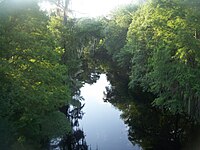Withlacoochee River (Florida)


The Withlacoochee River or Crooked River is a river in central Florida, in the United States. It originates in the Green Swamp, east of Polk City, flowing west, then north, then northwest and finally west again before emptying into the Gulf of Mexico near Yankeetown. The river is 141 miles (227 km) long[1] and has a drainage basin of 1,170 square miles (3,000 km2).
Along the route of central Florida's Withlacoochee River is the 46-mile-long (74 km) Withlacoochee State Trail, the longest paved rail trail in Florida;[2] the Cypress Lake Preserve, a 324-acre (1.31 km2) park with approximately 600 feet (180 m) of frontage;[3] and Nobleton Wayside Park, a 2-acre (8,100 m2) park in Nobleton that includes a boat ramp, shelter, basketball court, and picnic tables.
The Southwest Florida Water Management District operates a 5,484-acre (2,219 ha) nature preserve and recreational area with 3.7 miles (6.0 km) of frontage on the Withlacoochee River in Citrus County. The property was purchased for $13.5 million in 2005 from the South Florida Council, which had used it as the McGregor Smith Scout Reservation.[4]
The Withlacoochee River flows through Pasco and Hernando counties, and then forms part of the boundary between Hernando County and Sumter County and all of the boundary between Citrus County and Sumter County, between Citrus County and Marion County and between Citrus County and Levy County (including Lake Rousseau). The largest city close to the river is Dade City.
Tsala Apopka Lake is an area composed of a number of lakes, swamps and marshes interspersed with islands located in Citrus County within the bend of the river where it turns from north flowing to west flowing. The area was historically connected to the river by wetlands. Starting in the 1880s, canals were dug connecting the river to various parts of the lake area.[5] The area of Tsala Apopka Lake historically has been known as the "Cove of the Withlacoochee".[6]
History
[edit]On December 31, 1835, the Battle of Ouithlacoochie was fought on the banks of the river. It was one of the first engagements of the Second Seminole War.[7]
In the 1890s, logs, stumps, and other debris were removed from the river to facilitate the travel of barges carrying phosphate to Port Inglis. Phosphate continued to move along the river this way until WWI, when shipping lanes were closed, and then by the early 1930s, the phosphate deposits were completely depleted.[8]
Etymology
[edit]"Withlacoochee" probably stems from a Muskhogean dialect, which suggests that its application is comparatively recent. It is compounded of Creek we (water), thlako (big), and chee (little), or little big water. This word combination signifies little river in the Creek language, and as we-lako or wethlako may also refer to a lake, it may signify a river of lakes, or lake river.[9] An alternate etymology holds that Withlacoochee is a Native American word meaning "crooked river", which accurately describes the river as it makes its 70-mile (110 km) journey from the Green Swamp in northern Polk County to the Gulf of Mexico at Yankeetown.[10]
List of crossings
[edit]See also
[edit]References
[edit]- ^ U.S. Geological Survey. National Hydrography Dataset high-resolution flowline data. The National Map, accessed April 18, 2011
- ^ Withlacoochee State Trail (Florida Greenways and Trails)
- ^ "Hernando Parks".
- ^ Amy Wimmer, Schwarb (August 28, 2005). "Scouts sell land to water district". Tampa Bay Times. Retrieved June 10, 2020.
- ^ "Minimum and Guidance Levels for Tsala Apopka Lake in Citrus County, Florida" (PDF). Southwest Florida Water Management District. p. 5. Archived from the original (PDF) on 30 December 2006. Retrieved 28 April 2012.
- ^ Weisman, Brent (March–June 1986). "The Cove of the Withlacoochee: a First Look at the Archaeology of an Interior Florida Wetland". The Florida Anthropologist. 39 (1–2): 4–23. Retrieved 28 April 2012.
- ^ "Battle of the Withlacoochee" (PDF). University of Central Florida. Retrieved 24 March 2023.
- ^ Taylor, Sid. "From Devastation to Reforestation: The Story of the Withlacoochee State Forest" (PDF). www.fdacs.gov. Florida Department of Agriculture and Consumer Services. p. 7. Retrieved 25 March 2023.
- ^ Simpson, J. Clarence (1956). Mark F. Boyd (ed.). Florida Place-Names of Indian Derivation. Tallahassee, Florida: Florida Geological Survey.
- ^ "Withlacoochee State Forest / State Forests / Our Forests / Florida Forest Service / Divisions & Offices / Home - Florida Department of Agriculture & Consumer Services". Archived from the original on 2013-10-04. Retrieved 2013-10-04.
- ^ "The Lanier Bridge near Dade City, Pasco County, Florida". www.fivay.org.
Further reading
[edit]- Henderson, Rex. 1990. Withlacoochee River. in Marth, Del and Marty Marth, eds. The Rivers of Florida. Sarasota, Florida: Pineapple Press, Inc. ISBN 0-910923-70-1.
External links
[edit]- Withlacoochee South Paddling Trail and Withlacoochee North Paddling Trail from the Florida Department of Environmental Protection














